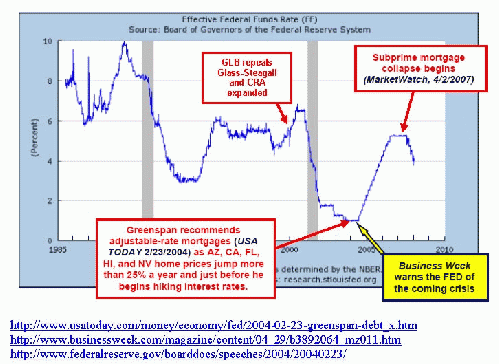In the wake of the financial meltdown on Wall Street, presidential candidates have offered us little more than campaign rhetoric. Bernanke and Paulson were bailing out some companies because they were "too big to fail."- Then Congress rushed the passage of a $700 billion bailout by loading it up with strategically chosen pork projects. After advocating swift passage of the now nearly one trillion dollar bill to advert a catastrophe, Paulson and Bush are just now implementing it.
Bailouts for "too big to fail"- banks is a solution that masks symptoms but does not cure the disease, which is found by identifying and understanding its causes. The American people understand how to solve problems, which is why they have such little faith in Congress and the Administration. Americans want the problem solved and protections to be put in place.
Oddly enough, laws that prevented banks from becoming "too big to fail"- were overturned by a compromise that was struck between the Republican Congress and the Clinton administration in late 1999. A New York Times article written by Stephen Labaton provides an excellent synopsis of this compromise late that year.
According to Labaton, this compromise was hatched "in a backroom meeting at the Capitol soon after midnight, when a group of moderate Senate Democrats -- led by Christopher Dodd of Connecticut and Charles E. Schumer of New York -- forced a compromise between [Senator Phil] Gramm and the White House over the legislation's effect on the Community Reinvestment Act, a 1977 anti-discrimination law intended to encourage lending to minorities and others historically denied access to credit."-
The compromise culminated in President Clinton signing the Gramm-Leach-Bliley Act (GLB) into law on November 12, 1999. This repealed the Glass-Steagall Act, allowing allowed banks to become "too big to fail"- and trade mortgage-backed securities and collateralized debt obligations via structured investment vehicles. Congressional Democrats put up little fight (only 8 Senators and 57 Representatives voted against the final version of the bill) because Republicans conceded expanding the Community Reinvestment Act (CRA), giving rise to creative subprime mortgages.
In a speech at HUD (June 18, 2002, 10:30 A.M. EDT), Bush said the following:
"We need more capital in the private markets for first-time, low-income buyers. And I'm proud to report that Fannie Mae has heard the call and, as I understand, it's about $440 billion over a period of time. They've used their influence to create that much capital available for the type of home buyer we're talking about here. It's in their charter; it now needs to be implemented. Freddie Mac is interested in helping. I appreciate both of those agencies providing the underpinnings of good capital."-
So, how did Fannie and Freddie help gather up $440 billion in capital? After gobbling up subprime mortgages, Fannie and Freddie repackaged them as mortgage backed securities and sold these to investment banks here and abroad.
While Fannie and Freddie were gathering up "good capital"- and restating over $10 billion in earnings, the Bush administration, according to a Washington Post article by Kathleen Day (10/8/2003), called for "tougher oversight"- and a "new regulator"- that would be independent of Treasury, which Barney Frank (D-MA) and Paul Kanjorski (D-PA) opposed.
Meanwhile, the Fed had lowered its target rate to one percentage point by mid-2003. Shortly thereafter, in a speech to the Credit Union National Association on February 23, 2004, Greenspan said, "homeowners might have saved tens of thousands of dollars had they held adjustable-rate mortgages rather than fixed-rate mortgages"- and "consumers might benefit if lenders provided greater mortgage product alternatives to the traditional fixed-rate mortgage."- So after duping borrowers and lenders, the Fed began a historic rate hike four months later, raising its target 425 basis points in just over two years.
All of the above when stirred in with speculative sellers selling homes to speculative buyers in housing markets appreciating at 20 to 30 percent a year and builders erecting homes faster than they can be flipped yields one heck of a financial Molotov cocktail.
So why were so many--especially Democrats--willing to throw Glass-Steagall under the bus? Was this not the legislation that President Franklin D. Roosevelt referred to as "the most important and far-reaching legislation ever enacted by the American Congress."-
In a Senate Banking Committee press release, Senator Gramm said: "We are here today to repeal Glass-Steagall because we have learned that government is not the answer"- [and] "that we promote economic growth and we promote stability by having competition and freedom."- How is increased competition possible when the purpose of GLB was to allow banks to become "too big to fail?"-
Clinton is quoted in Labaton's article saying: "it [GLB] will strengthen the economy and help consumers, communities and businesses across America."- A few years later, GLB helped its lead sponsor become vice-chairman of UBS--another one of those "too big to fail"- banks.
Laboton also quoted Clinton's treasury secretary, Lawrence Summers, who was reported saying: "At the end of the 20th century, we will at last be replacing an archaic set of restrictions with a legislative foundation for a 21st-century financial system"- [and] "would provide significant benefits to the national economy."- Such opinions are based on the idea that mergers are beneficial because gains accrue through increases in efficiency, decreases in redundancy, reductions in expenses, and declines in earnings volatility as economies of scale and scope are achieved. However, unfettered consolidation creates banks that are just "too big to fail."-
(Note: You can view every article as one long page if you sign up as an Advocate Member, or higher).





